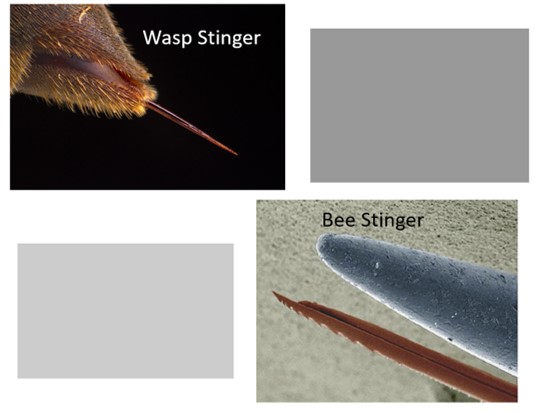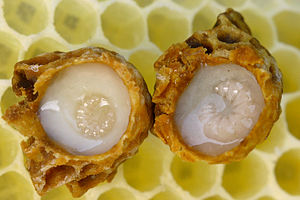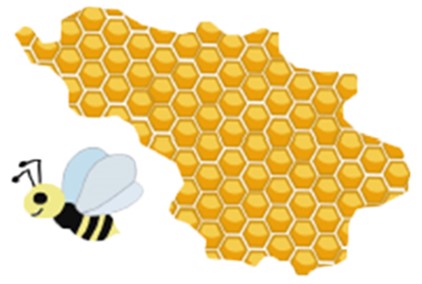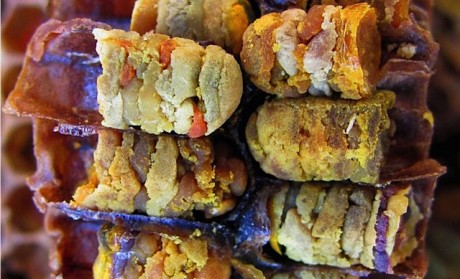The Worker Bee

When I am discussing honey bees at an event, most people ask about the queen. The worker bee, a sterile female has always been my “Super Hero”.
Worker honey bees’ job depends on their age:
This web page describes the Worker bee after she emerges from the cell. To learn about the days preceding her birth, see the web page:
1-2 days old: The workers clean the cell, starting with the one they were born in and keep brood warm.
3-5 days old: The job of the worker is to feed older larvae
6-11 days old: Workers are responsible for feeding the youngest larvae
12-17 days old: The bees’ wax glands are now mature and they can produce wax. In addition, they carry food, build comb and remove dead bees
18-21 days old: The workers protect the hive entrance.
From 22 days to the end of their life (at around 40-45 days): they fly from the hive and collect pollen, nectar, water, etc.
Not all workers do all the jobs. Some of them skip some tasks as they mature. The division of labor is not fixed. Bees can transition to the jobs needed.
Read about how the hive is managed thru the pheromones

Definition: Worker
A worker bee is any female (eusocial) bee that lacks the full reproductive capacity of the colony‘s queen bee. Worker bees occur in many bumble bee Bombus species as well as the honey bees. The stinger of a worker honey bee is barbed whereas the queen’s stinger, though barbed, is smoother than a worker and the drone does not have a stinger.
As the worker bee ages and their glands develop, their chores change to meet the needs of the hive. Throughout their life, approximately 45 days, workers are very productive. (Note: Days are approximate.)
1-3 Days Old
For the first three days, immediately following birth, (emerging from their cells), workers clean the cells in preparation for the queen to lay eggs and for storing food. They use their mandibles to scrape the inside of the cells to remove unwanted material. The debris tumbles down onto the hive floor where pollen mites and other debris-eating creatures take care of the unwanted material. These young worker bees also keep the brood warm. The temperature of the brood area must be kept approximately 90 degrees Fahrenheit all year long.
3-5 Days Old
Workers who are 3-5 days old feed the older larvae food called bee bread. Bee Bread is a mixture of pollen and honey/nectar. Scientists have found that in the process of making bee bread, the bees add extra secretions and micro-organisms such as bacteria and mold. These additions help break down some of the pollen and release amino acids and other nutrients from the pollen.

6-11 Days Old
From 6 to 11 days old, the hypopharynx gland is able to produce Royal Jelly, a gelatinous substance, necessary to feed newly hatched larvae. Each larva eats 800 times a day to build up the fat necessary to go through its pupae stage. Royal jelly is produced in the hypopharynx gland, located in the head of ‘nurse’ bees. Royal jelly is composed of approximately two-thirds water, one-eighth proteins, 11 per cent simple sugars, small quantities of Vitamin C and various trace minerals and enzymes. For more information on Royal Jelly
10 Days Old
When the bee reaches ten days old, the wax glands are now fully developed and the worker’s next job is to build comb. Comb is where food is stored and the eggs are laid. (To produce and build comb, the hive needs to be kept at approximately 90 degrees Fahrenheit. The 90 degree temperature allows the wax gland to secrete the wax and the mandibles to manipulate the wax to build the hexagonal cells.) Beeswax is a naturally occurring wax secreted mainly by honeybees for constructing honey combs (Tulloch, 1970a). Unhydrolyzed beeswax consists of approximately 71% esters, 15% hydrocarbons, 8% free fatty acids, and 6% other components (Tulloch, 1970b).
18-21 Days Old
At 18-21 days old workers become guard bees who protect the hive entrance. The worker bee’s venom, in the venom sack, is at its maximum potency. The guard bees stand at the hive entrance on their back four legs with their front legs raised which allows the Nasonov gland to emit a pheromone used in orientating forager bees back to the hive. Every bee is inspected by a guard bee before entering the hive. When the hive is attacked by large predators, such as the European Hornet, the honey bees cluster around the intruder. Then, each honeybee vibrates its wings, and the combined warming of honey bee bodies raises the temperature in the center of the cluster to 122 degrees F (50 degrees C), killing the hornet. Carbon dioxide levels in the nest also increase during this process, which contributes to the hornet’s death. May 17, 2020
22-45~ Days Old (To Death)
From 22 days to the end of their life, at around 40-45 days, the workers become foragers that fly from the hive and collect pollen, nectar, water, and sap (used in making propolis). Nectar is 70 to 95 percent water and 5 to 30 percent sucrose (table sugar). The bees add enzymes to the nectar. Then, they reduce the water through evaporation (fanning) to 18-20 percent.
To summarize the above, worker bees are responsible for:
• preserving honey
• feeding drones
• storing pollen
• removing the dead
• foraging for food and nectar
• carrying in water
• fanning the hive to maintain the proper temperature
• guarding the hive against invaders such as wasps
• deciding when the hive needs to divide/swarm

